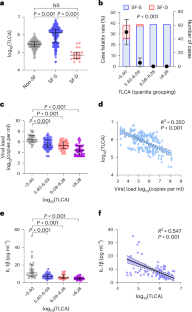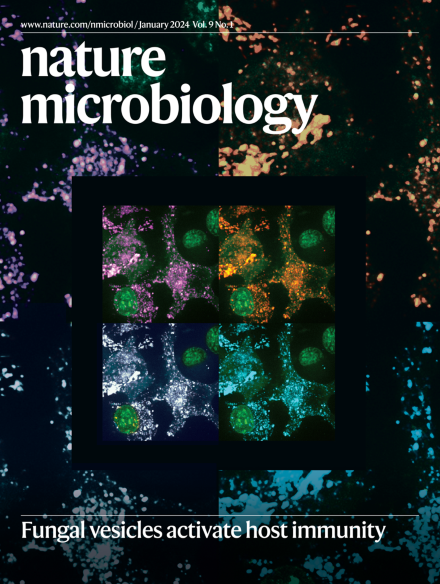牛磺胆硷酸通过抑制铁变态反应预防病毒性出血热
IF 20.5
1区 生物学
Q1 MICROBIOLOGY
引用次数: 0
摘要
胆汁酸是微生物代谢产物,可影响肠道病毒和肝炎病毒的感染,但其在全身病毒感染期间的功能仍不清楚。在这里,我们发现二级胆汁酸牛磺胆硷酸(TLCA)水平的升高与感染严重发热伴血小板减少综合征病毒(SFTSV)(一种新出现的蜱媒出血热病毒)的患者死亡率的降低和病毒血症的抑制有关。在体外感染 SFTSV 期间,TLCA 可抑制病毒复制和减轻宿主炎症,并通过 TGR5-PI3K/AKT-SREBP2 轴上调脂肪酸去饱和酶 2 间接抑制 SFTSV 介导的铁变态反应。在感染早期,血清中铁和铁蛋白水平过高与TLCA水平降低和SFTSV感染患者的死亡结果相关,这表明铁和铁蛋白是潜在的生物标志物。此外,使用铁蛋白抑制剂或TLCA治疗可保护小鼠免受致命的SFTSV感染。我们的研究结果凸显了胆汁酸治疗出血热病毒感染的潜力。本文章由计算机程序翻译,如有差异,请以英文原文为准。


Taurolithocholic acid protects against viral haemorrhagic fever via inhibition of ferroptosis
Bile acids are microbial metabolites that can impact infection of enteric and hepatitis viruses, but their functions during systemic viral infection remain unclear. Here we show that elevated levels of the secondary bile acid taurolithocholic acid (TLCA) are associated with reduced fatality rates and suppressed viraemia in patients infected with severe fever with thrombocytopenia syndrome virus (SFTSV), an emerging tick-borne haemorrhagic fever virus. TLCA inhibits viral replication and mitigates host inflammation during SFTSV infection in vitro, and indirectly suppresses SFTSV-mediated induction of ferroptosis by upregulating fatty acid desaturase 2 via the TGR5–PI3K/AKT–SREBP2 axis. High iron and ferritin serum levels during early infection were correlated with decreased TLCA levels and fatal outcomes in SFTSV-infected patients, indicating potential biomarkers. Furthermore, treatment with either ferroptosis inhibitors or TLCA protected mice from lethal SFTSV infection. Our findings highlight the therapeutic potential of bile acids to treat haemorrhagic fever viral infection. A microbially derived bile acid, taurolithocholic acid, limits viral replication, host inflammation and ferroptosis during infection with severe fever with thrombocytopenia syndrome virus, an emerging tick-borne haemorrhagic fever virus.
求助全文
通过发布文献求助,成功后即可免费获取论文全文。
去求助
来源期刊

Nature Microbiology
Immunology and Microbiology-Microbiology
CiteScore
44.40
自引率
1.10%
发文量
226
期刊介绍:
Nature Microbiology aims to cover a comprehensive range of topics related to microorganisms. This includes:
Evolution: The journal is interested in exploring the evolutionary aspects of microorganisms. This may include research on their genetic diversity, adaptation, and speciation over time.
Physiology and cell biology: Nature Microbiology seeks to understand the functions and characteristics of microorganisms at the cellular and physiological levels. This may involve studying their metabolism, growth patterns, and cellular processes.
Interactions: The journal focuses on the interactions microorganisms have with each other, as well as their interactions with hosts or the environment. This encompasses investigations into microbial communities, symbiotic relationships, and microbial responses to different environments.
Societal significance: Nature Microbiology recognizes the societal impact of microorganisms and welcomes studies that explore their practical applications. This may include research on microbial diseases, biotechnology, or environmental remediation.
In summary, Nature Microbiology is interested in research related to the evolution, physiology and cell biology of microorganisms, their interactions, and their societal relevance.
 求助内容:
求助内容: 应助结果提醒方式:
应助结果提醒方式:


